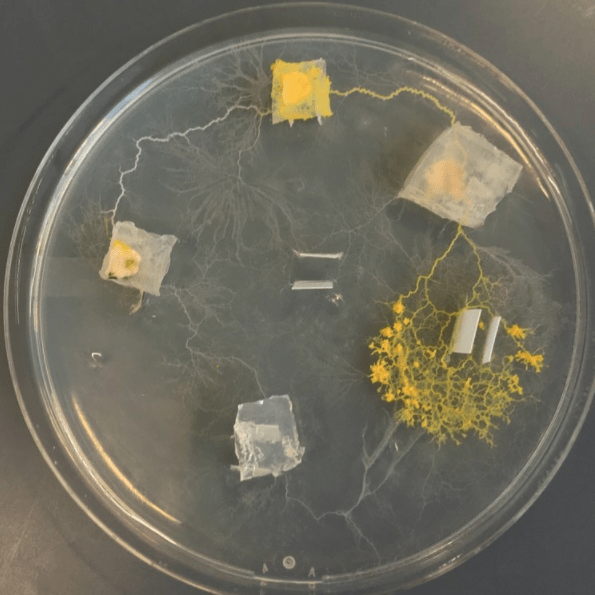Rethinking Intelligence
by Samm Smith
It was like a marriage. A joining of disparate entities. Perhaps it was God who created this union. Intelligence, it seemed, was a composite. It was a bond between behavior and intention. “Behavior,” or responses of the body did not always match with “intention,” or plans of the mind. They were an uncomfortable match, but a match that changed the world.
Intelligence might have needed a brain. For early modern neuroscientists like Thomas Willis (1621-1675) the brain was essential for rational human minds. But perhaps intelligence could also function in the absence of a brain. How do we shift our views of intelligence? Slightly eccentric amoeba-esque slime mold might be the last place to look for so-called intelligence, but that makes it more exciting.
In 2004, it was not the first-time slime mold made an appearance[1], but this time seemed consequential. Kobe University Nada researchers noticed Physarum polycephalum exhibited emergent computing behavior[2]. Later, Tomoyuki Miyaji from Hiroshima University computationally analyzed the mold’s complex behavior using a rigorous equation that explained its ability to solve the “shortest-path problem.”[3]
In 2010, researcher Andy Adamatzsky further showed the “true” computational prowess of Physarum by demonstrating foraging behavior that mimicked the motorway system of the United Kingdom[4] when oats were placed at major urban centers on a UK-shaped agar plane. That is, the structure of the UK roadway system (and others[5]) designed by a team of intelligent human beings, was recreated by an acellular slime mold.
How can we understand the “pseudo”-intelligence of this species and how can our conception of intelligent behavior be shifted by these narratives? What do these experiments tell us about the way in which sensation and perception might work for these creatures? Can sensation arise without a nervous system? Are “emergent properties” enough to downplay the truth of intelligence?
References:
Adamatzky, A., & Jones, J. (2010). Road Planning With Slime Mould: If Physarum Built Motorways It Would Route M6/m74 Through Newcastle. International Journal of Bifurcation and Chaos, 20(10), 3065-3084. doi:10.1142/s0218127410027568
Kauffman, S., & Wille, J. J. (1975). The mitotic oscillator in Physarum polycephalum. Journal of Theoretical Biology, 55(1), 47-93. doi:10.1016/s0022-5193(75)80108-1
Miyaji, T., & Ohnishi, I. (2008). PHYSARUM CAN SOLVE THE SHORTEST PATH PROBLEM ON RIEMANNIAN SURFACE MATHEMATICALLY RIGOROUSLY. International Journal of Pure and Applied Mathematics, 47(3), 353-369.
Tsuda, S., Aono, M., & Gunji, Y. (2004). Robust and emergent Physarum logical-computing. Biosystems, 73(1), 45-55. doi:10.1016/j.biosystems.2003.08.001
Instagram Link:
https://www.instagram.com/phy.sarum/
NOTES
[1] Physarum has been studied in cell biology for years to look at mechanisms like mitotic oscillators; it has not been until recently that its computational abilities have been looked at. Kauffman, S., & Wille, J. J. (1975). The mitotic oscillator in Physarum polycephalum. Journal of Theoretical Biology, 55(1), 47-93. doi:10.1016/s0022-5193(75)80108-1
[2] Tsuda, S., Aono, M., & Gunji, Y. (2004). Robust and emergent Physarum logical-computing. Biosystems, 73(1), 45-55. doi:10.1016/j.biosystems.2003.08.001 `
[3] Miyaji, T., & Ohnishi, I. (2008). PHYSARUM CAN SOLVE THE SHORTEST PATH PROBLEM ON RIEMANNIAN SURFACE MATHEMATICALLY RIGOROUSLY. International Journal of Pure and Applied Mathematics, 47(3), 353-369.
[4] Adamatzky, A., & Jones, J. (2010). Road Planning With Slime Mould: If Physarum Built Motorways It Would Route M6/m74 Through Newcastle. International Journal of Bifurcation and Chaos, 20(10), 3065-3084. doi:10.1142/s0218127410027568
[5] Physarum has also been used to recreate railway systems in Tokyo (https://www.wired.com/2010/01/slime-mold-grows-network-just-like-tokyo-rail-system/) and the U.S. (https://www.youtube.com/watch?v=82hXb0eS52Y).
